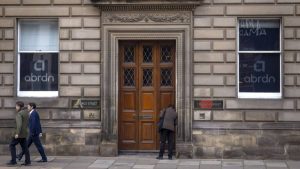
It was, as one economist put it, “a brutal day across risky markets” when on September 15 the S&P 500 shed a massive 4.7 per cent — its biggest one-day decline in seven years. “An ugly day in stocks,” he added. “Locusts” were picking off victims across global stocks, another market watcher agreed.
The verdict on the front page of this newspaper was blunt. “Day of reckoning on Wall Street”, the headline declared, complete with a large picture of despondent-looking bankers in Canary Wharf.
If you think something feels slightly off here, you are right. That September 15 shock to markets was in 2008, not 2022. Those despondent bankers were standing outside Lehman Brothers’ European headquarters and Bank of America had just swallowed Merrill Lynch as the global financial system frayed at the seams.
Fast forward almost exactly 14 years and history is not repeating, but it is certainly rhyming.
This time around, on September 13 the S&P 500 benchmark index of US stocks dropped by more than 4 per cent — a fall on a scale not seen since the Covid crisis began more than two years ago. The Nasdaq Composite fared even worse, losing 5.2 per cent. Bizarre as it seems, the post-Covid recovery phase of 2022 is churning out moments in the market as ugly as in the week Lehman Brothers told shocked staff “it’s over”. Even more bizarre: somehow, we have become accustomed to the blows.
Perhaps that is because the investors have suffered a fainting fit every time this year that US inflation data has turned out to be surprisingly strong. This week was no exception. US consumer price inflation rocked in at 8.3 per cent for August, according to figures released by the Bureau of Labor Statistics on Tuesday. That is a little better than the 8.5 per cent figure for July. The problem is that analysts and investors had been expecting a tamer 8.1 per cent pace, particularly given the rapid pullback in petrol prices. The rate also picked up 0.1 per cent in August from the previous month.
Yet again, this has torpedoed the long wished-for pivot from the US Federal Reserve — the mythical moment when it decides to dial down the interest rate rises that have been pummeling asset prices this year. Yet again, the hopeful pundits are disappointed and the beatings will continue until morale improves.
Traders now see a reasonable chance that the Fed will lift rates by a blockbuster full percentage point at next week’s meeting. Anything less than three-quarters of a point would be a huge surprise.
BlackRock rather gnomically compares this situation to Knut, the polar bear. For those who had forgotten the story of Knut (myself included), the investment house reminds us that the newborn cub was rejected by his mother at Berlin Zoo in 2006.
“A zookeeper stepped in to raise him by bottle. But some argued it would be better for the bear to be killed than raised by humans,” wrote Jean Boivin and Alex Brazier. “A media frenzy and widespread protests followed, ultimately saving Knut’s life. To our mind, central bankers seem to have a bit of a ‘let the bear die’ mentality right now (for bear, read the economy). It seems they would rather just let the economy die to avoid any risk of inflation expectations de-anchoring.”
Crudely, where the economy goes, your portfolio probably follows. It might be time to find a friendly zookeeper, or some sympathetic protesters.
The thing is, as all but the very youngest polar bears are surely aware, this is not new. So why does the market convulse every time it receives a reminder? “It’s the attempted triumph of hope over experience,” says Trevor Greetham, head of multi-asset at Royal London Asset Management. “If you’d said to any of us three years ago that we would be looking at 22 per cent inflation in the UK if it wasn’t for government action on energy prices, we would not have believed you. It’s a massive regime change. People still want inflation to be transitory and temporary.” It is not.
In addition to 2008-style lurches lower in stocks, this all generates huge swings in the dollar and in the typically more sober government bond market. Some analysts fret that longstanding structural flaws in the debt market are becoming dangerous. The BofA has described cracks in US Treasuries as “one of the greatest threats to global financial stability today, potentially worse than the housing bubble of 2004-2007”. If ripples are left unchecked, quantitative tightening — the process of the Fed cutting back its crisis-era balance sheet — could prove to be the factor that tips this market over the edge.
We should all hope not and a lot of these technicalities are white noise to non-specialists. But Greetham puts it delightfully simply: “Whether it’s QT or just an almighty wrongfooting of central banks by the Covid crisis, it’s the same thing.” Hindsight is a beautiful thing, but it is clearer by the day that markets were overly lavishly supported by central banks for too long. Correcting this imbalance will keep on sparking the ugly declines and head-fake bear market rallies that characterised the crisis of 2008-2009.

